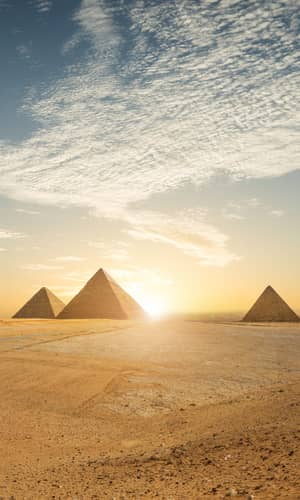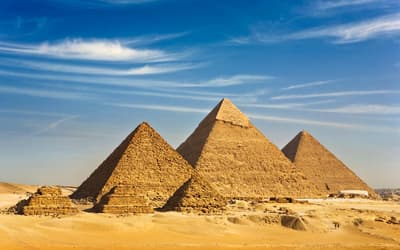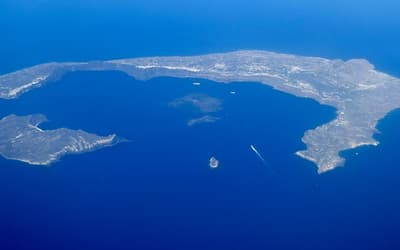The views expressed in this paper are those of the writer(s) and are not necessarily those of the ARJ Editor or Answers in Genesis.
Abstract
Pottery and stratigraphy show that it is impossible to run Dynasty 6 of the Old Kingdom in parallel with Dynasty 12 of the Middle Kingdom as some Christian chronologers claim.
Keywords: Old Kingdom, Dynasty 6, Middle Kingdom, Dynasty 11, Dynasty 12, Pottery, Stratigraphy, Radiocarbon Dating
It is a common belief among Christian chronologers, including Anne Habermehl (2022) and John Osgood (2022a, b), that instead of the orthodox sequence (Old Kingdom, First Intermediate Period, Middle Kingdom, Second Intermediate Period), parts of the Old and Middle Kingdoms can be run in parallel and the Intermediate Periods were contemporary with each other. This is in contrast to my own approach which was to keep the sequence but shorten its parts (Porter 2022). Obviously Habermehl’s approach would greatly shorten chronology, but it is not possible for the reasons given below. Habermehl notes that “Porter claims that it is impossible for these two dynasties [that is, Dynasty 6 of the Old Kingdom and Dynasty 12 of the Middle Kingdom] to have run concurrently but does not give reasons to support his statement.” I had briefly stated that such a concurrence was “impossible because it would contradict archaeological sequences both stratigraphically and in terms of pottery styles.” Let me now elaborate on these points and add a few more.
Pottery
As an example of changing pottery styles, when I was young I drank tea, made in a teapot, from a cup and saucer, but now I use a tea-bag and drink from a mug! After hundreds of archaeological expeditions to Egypt, experts can tell the difference between Old Kingdom and Middle Kingdom pottery, and there are illustrated manuals showing the various types of vessels from different periods, for example, Wodzinska (2009).
Stratigraphy
In some places Middle Kingdom remains occur above Old Kingdom remains, thus showing a sequence. It is actually quite difficult to find conclusive examples, but two are given below.
At Bubastis in the eastern Nile Delta, a Middle Kingdom palace was built partly above an Old Kingdom cemetery. The excavation phases run timewise as follows:
- Phase k “Necropolis of the late Old Kingdom including an elite necropolis in the east (6th Dynasty)”
- Phase i “Older phase of the Middle Kingdom palace (12th Dynasty)”
- Phase h/2 “Palace of the Middle Kingdom . . . (late 12th–13th Dynasties)”
- Phase h/1 “Tombs of the Second Intermediate Period cutting into the palace and the Middle Kingdom settlement”
- (Quoted from Bietak 2019, 208; see also figs. 6, 7 and 8 showing Middle Kingdom walls cutting down into the Old Kingdom cemetery).
Before we leave Bubastis in northern Egypt, note that it has a large temple of Pepi I of mid Dynasty 6 (for example, Lange-Athinodoru and es-Senussi 2018), apparently contradicting Habermehl’s statement that “Osgood and I maintain, Dynasty XII was ruling in the north as the dominant dynasty (while the sixth dynasty was reigning in the south, subservient to the twelfth reigning in the north)”. It should also be pointed out that Old and Middle Kingdom pharaohs all built their main pyramids in the North in a strip of land running about 55 miles south from Cairo, and none in southern Egypt.
Another stratigraphic example can be found at Elephantine, an ancient settlement on an island in the Nile at modern Aswan in southern Egypt. The town goddess of Elephantine was Satet and her temple was maintained and rebuilt through the ages. A summary can be found on Wikipedia, “Temple of Satet” (accessed 29 April, 2022). Greater detail for Dynasties 6–early 11 is given in Dreyer 1986, 20–22, figs. 4–5 and 7, and for subsequent dynasties in Kopp 2020, 26–30. Dreyer (1986, 30, fig. 7), repeated in Kopp (2020, 33, fig. 7), gives a section drawing through the temple showing, from left to right, the rock niche holy place at the left (“Felsnische”), the courtyard (“Hof”) with altar in the middle, and the courtyard outer wall (“Hofmauer”). The floor of the temple was renewed from time to time and the section shows a sequence of numerous earth floors running up from the Early Dynastic period to later ones of Dynasties 6 and early 11, then stone paving of later 11–12. Plan views of the Dynasty 6 and early 11 temples are shown in Dreyer (1986) figs 4 and 5 respectively. The same plan views are also shown in Kopp (2020) plus probable reconstructions of the later Dynasty 11 and 12 temples for which only the stone paving remained. Numerous small religious offerings were scattered through the earthen floors, amongst which, in the Dynasty 6 layers were seven plaques naming Pepi I and two naming Pepi II (Dreyer 1986, 20–22). In the courtyard, above the last floor of Dynasty 6 were some indistinct floors of Dynasty 11 and a filling below the Dynasty 11 paving. These floors and filling included a mixture of new and old types of offerings including more fragments naming Pepi I and II mixed in (Dreyer 1986, 22). The key point is that above these earth floors and fillings of Dynasties 6 and early 11 were limestone paving slabs from stone-built temples of later Dynasty 11 and 12. Unfortunately, there are no in situ inscriptions of Dynasty 11 or 12, but there are a number of sandstone architectural fragments from these later temples, some found reused nearby and some in the filling above the Dynasty 11–12 pavings and under the later Dynasty 18 floor of the temple. One uninscribed sandstone fragment was found in situ (Kaiser et al. 1975, 46, no. 3, n. 25). Some inscribed sandstone fragments were found in the “Granitfüllung”, the stone filling, mostly granite, above the Dynasty late 11–12 floors and under the Dynasty 18 floor. For example, two door post fragments naming Intef II of early Dynasty 11 were found in the fill (Kaiser et al. 1975, 46, no. 2, n. 24, plate 19); and two slabs also named Intef II (Kaiser et al. 1975, nos. 4 and 6, nn. 26 and 28, plates 19e and 20b). None of these also name Satet but from their location they have been reasonably allocated to her temple. Since the OK Satet temples were all brick built, not stone, it follows that the inscribed stone elements went with the later Dynasty 11–12 temples with stone pavings and came after the brick built temples of Dynasty 6.
Elsewhere at Elephantine is a Dynasty 12 shrine to Heqaib Pepinakhte, a renowned governor from Dynasty 6 who was deified and still revered in later times. Apparently he was an exemplary governor of Elephantine, and conducted military operations and other services for the pharaoh. From his name it is deduced that he lived under one of the Pepi pharaohs of Dynasty 6, and this is confirmed in his tomb across the river at Qubbet el-Hawa where his numerous job titles include having charge of the pyramids of Pepi I, Merenre I and Pepi II (Tomb T35; Edel 2008, 686, 698). At the shrine, numerous inscriptions commemorated Heqaib, on stelae and statues placed by characters from Dynasty 12, including royalty (Habachi 1956, and in greater detail, Habachi 1985). This cannot be taken to show that Heqaib of Dynasty 6 was contemporary with Dynasty 12 because a stela of Sarenput I, a governor of Elephantine in early Dynasty 12, states that he rebuilt Heqaib’s shrine which was “much ruined . . . . All its chambers were full of rubble” (Habachi 1985, 36–37, 140), that is, it had been neglected for some lengthy time. Thus, we have a Dynasty 6 governor remembered much later in Dynasty 12, confirming the orthodox sequence of dynasties.
Radiocarbon Dating
Although we do not accept the BC dates from carbon dating, they do give an approximate sequence. In a large study by Oxford University, the carbon dates clearly distinguished between Old and Middle Kingdom samples (Bronk Ramsey et al. 2010). If one refers to Table S1 in their supplementary online material, it is apparent that the uncalibrated ages for Dynasties 3–6 are in the region of 4,000 radiocarbon years whereas for Dynasty 12 they are in the region of 3,500, thus a consistent difference of about 500 radiocarbon years. Note that the samples were allocated to dynasties by Egyptologists before they were carbon dated.
References
Bietak, Manfred. 2019. “Bubastis: A Palace for a King or a Provincial Administrative Centre?” In Ancient Egyptian and Ancient Near Eastern Palaces, Vol. 2, edited by M. Bietak, P. Matthiae, and S. Prell. Wiesbaden, Germany: Harrassowitz.
Bronk Ramsey, Christopher, Michael W. Dee, Joanne M. Rowland, Thomas F. G. Higham, Stephen A. Harris, Fiona Brock, Anita Quiles, et al. 2010. “Radiocarbon-Based Chronology for Dynastic Egypt.” Science 328, no. 5985 (18 June): 1554–1557.
Dreyer, Günter. 1986. Elephantine VIII: Der Tempel der Satet: die Funde der Frühzeit und des Alten Reiches. Mainz am Rhein, Germany: Philipp von Zabern.
Edel, Elmar. 2008. Die Felsgräbernekropole der Qubbet el- Hawa bei Assuan: I. Abteilung, Band 2. Parderborn, Germany: Schöningh.
Habachi, Labib. 1956. “Hekaib, the Deified Governor of Elephantine”. Archaeology 9, no. 1 (March): 8–15.
Habachi, L. 1985. Elephantine IV: The Sanctuary of Heqaib. 2 vols. Mainz am Rhein, Germany: Philipp von Zabern.
Habermehl, Anne. 2022. “The Place of the Exodus in Egyptian History: Comments.” Answers Research Journal 15: 121–123.
Kaiser, W. et al. 1975. “Stadt und Tempel von Elephantine: Fünfter Grabungsbericht”. Mitteilungen des Deutschen Archäologisches Instituts Kairo 31: 39–84.
Kopp, Peter. 2020. Elephantine IX: Der Tempel der Satet: die Funde des späten Alten bis Neuen Reichs. Wiesbaden, Germany: Harrassowitz.
Lange-Athinodoru, E., and A. es-Senussi. 2018. “A Royal Ka- Temple and the Rise of Old Kingdom Bubastis”. Egyptian Archaeology 53 (Autumn): 20–24.
Osgood, A. John M. 2022a. “The Place of the Exodus in Egyptian History: Comments.” Answers Research Journal 15 (March 2): 21–23. https://answersresearchjournal.org/ancient-egypt/place-of-exodus-egyptian-history-comments/.
Osgood, A. John M. 2022b. “The Place of the Exodus in Egyptian History: Reply.” Answers Research Journal 15: 129–130.
Porter, Robert M. 2022. “The Place of the Exodus in Egyptian History.” Answers Research Journal 15 (February 16): 1–9. https://answersresearchjournal.org/ancient-egypt/place-of-exodus-egyptian-history/.
Wodzinska, Anna. 2009. A Manual of Egyptian Pottery: Vol. 2, Naqada III—Middle Kingdom. Boston, Massachusetts: Ancient Egyptian Research Associates.




